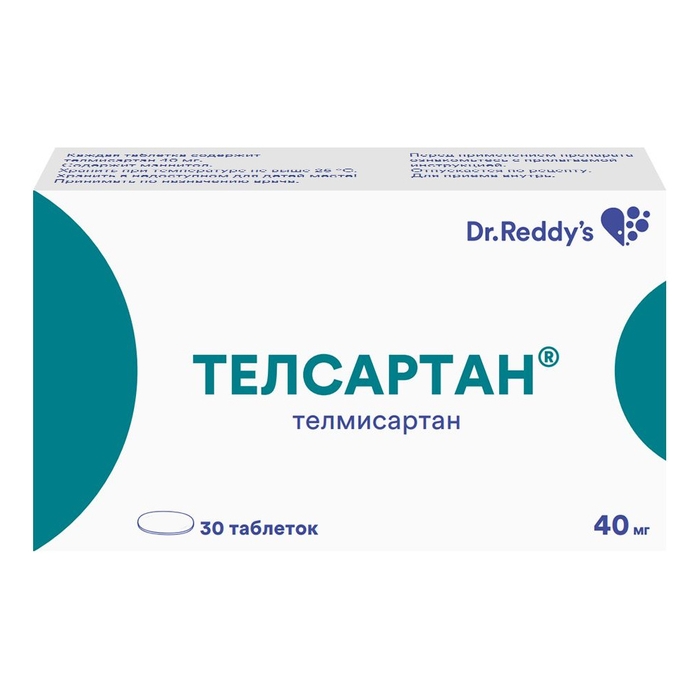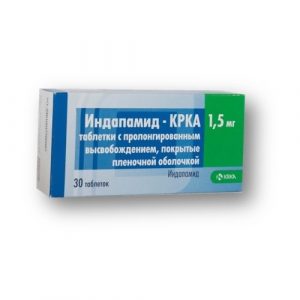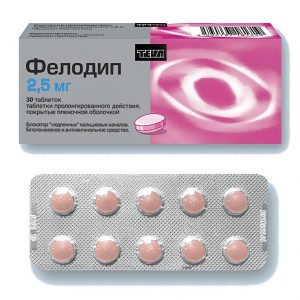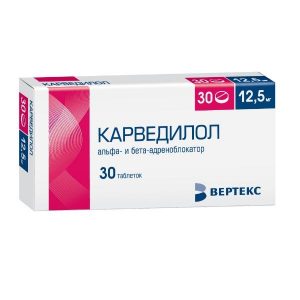Description
Release form
Tablets
Pharmacological action of
Pharmacodynamics of
Telmisartan is a specific angiotensin (ARA) II receptor antagonist, type AT1, effective when taken orally. It has a high affinity for the AT1 subtype of angiotensin II receptors, through which the action of angiotensin II is realized. Displaces angiotensin II from the connection with the receptor, not possessing the action of an agonist in relation to this receptor. Telmisartan binds only to the AT1 subtype of angiotensin II receptors.
Communication is continuous. It has no affinity for other receptors, including the AT2 receptor and other less studied receptors of angiotensin. The functional significance of these receptors, as well as the effect of their possible excessive stimulation with angiotensin II, the concentration of which increases with the appointment of telmisartan, not studied. It reduces the concentration of aldosterone in the blood, does not inhibit renin in blood plasma and does not block ion channels. Telmisartan does not inhibit the angiotensin converting enzyme (kininase II), which also destroys bradykinin. Therefore, an increase in the side effects caused by bradykinin is not expected.
In patients with arterial hypertension, telmisartan at a dose of 80 mg completely blocks the hypertensive effect of angiotensin II. The onset of antihypertensive action is noted within 3 hours after the first oral administration of telmisartan. The effect of the drug persists for 24 hours and remains significant up to 48 hours.
A pronounced antihypertensive effect usually develops 4 weeks after regular use of the drug.
In patients suffering from arterial hypertension, telmisartan lowers systolic and diastolic blood pressure (BP) without affecting the heart rate (HR).
In the case of abrupt cancellation of telmisartan, blood pressure gradually returns to its original level without the development of the “withdrawal” syndrome.
Pharmacokinetics
Absorption
When taken orally, it is rapidly absorbed from the gastrointestinal tract. Bioavailability is about 50%. When taken at the same time as food, the decrease in the area under the concentration-time pharmacokinetic curve (AUC) ranges from 6% (at a dose of 40 mg) to 19% (at a dose of 160 mg). 3 hours after ingestion, the concentration in the blood plasma is leveled regardless of the meal.
Distribution of
Communication with blood plasma proteins – 99.5% (mainly with albumin and alpha-1 glycoprotein). The average value of the apparent volume of distribution in equilibrium concentration is 500 liters.
Metabolism
Metabolized by conjugation with glucuronic acid. Metabolites are pharmacologically inactive.
Withdrawal
Elimination half-life (T1 / 2) – more than 20 hours. It is excreted through the intestine unchanged, excretion by the kidneys – less than 2% of the dose taken. The total plasma clearance is high (900 ml / min) compared with hepatic blood flow (about 1500 ml / min).
Pharmacokinetics in special patient groups
Gender differences
There is a difference in plasma concentrations of telmisartan in men and women. The maximum plasma concentration (Cmax) is approximately 3 times and the AUC is approximately 2 times higher in women compared with men without a significant effect on effectiveness. Dose adjustment is not required.
Elderly patients
The pharmacokinetics of telmisartan in elderly patients are not different from the pharmacokinetics in young patients. Dose adjustment is not required.
Patients with impaired renal function
In patients with mild to moderate impaired renal function, dose adjustment of telmisartan is not required.
Patients with severe renal impairment and those on hemodialysis are recommended a lower initial dose of 20 mg per day.
Telmisartan is not excreted by hemodialysis.
Patients with impaired liver function
Pharmacokinetics studies in patients with hepatic impairment showed an increase in the absolute bioavailability of telmisartan to almost 100%. With liver failure, T1 / 2 does not change. In patients with mild to moderate hepatic impairment (Child-Pugh classification A and B), the daily dose should not exceed 40 mg.
Indications
Arterial hypertension.
Decreased cardiovascular morbidity and mortality in patients 55 years of age and older with a high risk of cardiovascular disease.
Contraindications
Hypersensitivity to the active substance or auxiliary components of the drug.
Pregnancy and the period of breastfeeding.
Obstructive biliary tract disease.
Severe hepatic impairment (Child-Pugh class C).
Concomitant use with aliskiren and drugs containing aliskiren in patients with diabetes mellitus and / or moderate or severe impaired renal function (glomerular filtration rate (GFR) less than 60 ml / min / 1.73 m2 of body surface area).
Concomitant use with angiotensin-converting enzyme inhibitors in patients with diabetic nephropathy.
Age under 18 years (efficacy and safety not established).
Precautions: Bilateral renal artery stenosis or artery stenosis of a single kidney (see “Special Instructions”).
Mild to moderate impairment of liver and / or kidney function (see Special Instructions).
Decreased circulating blood volume (BCC) due to previous diuretic therapy, restriction of salt, diarrhea, or vomiting.
Hyponatremia.
Hyperkalemia.
Conditions after kidney transplantation (no experience with use).
Chronic heart failure.
Stenosis of the aortic and mitral valve.
Idiopathic hypertrophic subaortic stenosis (hypertrophic obstructive cardiomyopathy).
Primary hyperaldosteronism.
Use during pregnancy and lactation
Pregnancy
Medicines that directly affect the RAAS can cause serious damage and death of the developing fetus, therefore, when planning or establishing the fact of pregnancy, the drug should be immediately canceled and, if necessary, alternative antihypertensive therapy should be prescribed having an established safety profile for use during pregnancy. The use of the drug during pregnancy is contraindicated.
In preclinical studies of telmisartan, teratogenic effects were not detected, but fetotoxicity was established. Known that the effect of angiotensin II receptor antagonists during the second and third trimesters of pregnancy causes fetotoxicity in a person (decreased renal function, oligohydramnios, delayed ossification of the skull), as well as neonatal toxicity (renal failure, hypotension, hyperkalemia). Patients planning a pregnancy should be prescribed alternative therapy. If treatment with angiotensin II receptor antagonists occurred during the second trimester of pregnancy, ultrasound testing of the kidney function and the condition of the skull in the fetus is recommended.
Newborns whose mothers received angiotensin II receptor antagonists should be closely monitored for hypotension.
Breastfeeding period
Breastfeeding is contraindicated during telmisartan therapy.
Fertility
Studies on the effects on human fertility have not been conducted.
Special instructions
Impaired liver function
Telmisartan is contraindicated in patients with cholestasis, biliary obstruction, or severe impaired liver function (Child-Pu class C), since telmisartan is excreted primarily with bile. In such patients, a decrease in excretion of the drug is expected. Telmisartan should be used with caution in patients with mild or moderate hepatic impairment (class A or B according to the Child-Pugh classification).
Vasorenal arterial hypertension
When using drugs that affect RAAS in patients with bilateral renal artery stenosis or stenosis of a single functioning kidney, the risk of developing severe arterial hypotension and renal failure is increased.
Impaired renal function
When using telmisartan in patients with renal failure, it is recommended that serum potassium and creatinine levels be monitored. The experience of using after a recent kidney transplant has not been described.
Hypovolemia
In patients with hypovolemia and / or hyponatremia due to intensive diuretic therapy, limiting salt intake, diarrhea or vomiting may develop symptomatic arterial hypotension, especially after taking the first dose of telmisartan. Before starting therapy, violations of the water-electrolyte balance should be adjusted.
Double blockade of RAAS
The simultaneous use of ACE inhibitors, ARA II or aliskiren increases the risk of hypotension, hyperkalemia and impaired renal function (including acute renal failure), so the use of a combination of these drugs is regarded as double blockade of RAAS.
The simultaneous use of ARA II with drugs containing aliskiren is contraindicated in patients with diabetes mellitus and / or with moderate or severe renal failure (GFR less than 60 ml / min / 1.73 m2 of body surface area) and is not recommended in other patients. The simultaneous use of ARA II with ACE inhibitors is contraindicated in patients with diabetic nephropathy and is not recommended in other patients.
When absolutely necessary, therapy using the double blockade of RAAS should be carried out under strict medical supervision and careful monitoring of renal function, electrolytes and blood pressure.
Other conditions associated with activation of RAAS
In patients whose vascular tone and renal function is determined by RAAS activity (patients with chronic heart failure or kidney disease, including stenosis of two renal arteries or stenosis of a single kidney artery), the use of drugs that affect RAAS, may be accompanied by the development of arterial hypotension, hyperazotemia, oliguria, and in rare cases, acute renal failure.
Primary hyperaldosteronism
Patients with primary hyperaldosteronism are resistant to antihypertensive drugs that affect RAAS, so telmisartan is not recommended for such patients.
Aortic and / or mitral valve stenosis, hypertrophic obstructive cardiomyopathy (GOKMP)
Telmisartan should be used with caution in patients with hemodynamically significant stenosis of the aortic and / or mitral valves or with GOKMP.
Patients with diabetes receiving insulin or hypoglycemic agents for oral administration
When using telmisartan, such patients may develop hypoglycemia. It is recommended to regularly monitor the concentration of blood glucose and, if necessary, adjust the dose of hypoglycemic agents.
Hyperkalemia
The use of drugs that affect RAAS can cause hyperkalemia. Before the simultaneous use of such drugs, the benefit / risk ratio should be assessed.
Risk factors for the development of hyperkalemia:
– renal failure, over 70 years old, diabetes mellitus
– simultaneous use of drugs that affect RAAS (ACE inhibitors, ARA II) and / or potassium-sparing diuretics (spironolactone, eplerenone, triamterene, amiloride) potassium or potassium-containing substitutes for edible salt, NSAIDs (including COX-2 selective), heparin, immunosuppressive drugs (cyclosporine or tacrolimus), as well as trimethoprim
– concomitant conditions such as dehydration, acute heart failure decompensation, metabolic acidosis, impaired renal function, sudden progression of kidney disease (infectious diseases), conditions accompanied by tissue necrosis (acute limb ischemia, rhabdomyolysis, extensive trauma).
Patients at risk should be closely monitored for serum potassium concentrations.
Ethical features
ACE inhibitors and ARA II (including telmisartan) may have a less pronounced antihypertensive effect in patients of the Negroid race.
Perhaps this is due to a decrease in renin levels in patients with arterial hypertension compared with other races.
Other
As with any antihypertensive drug, an excessive decrease in blood pressure in patients with coronary artery disease or ischemic cardiomyopathy can lead to myocardial infarction or stroke.
There have been no special clinical studies evaluating the effect of the drug on the ability to drive a car and machinery. However, when driving and engaging in hazardous activities, the possibility of developing dizziness and drowsiness should be taken into account, which requires caution.
Composition
1 tablet 40 mg contains:
Active ingredient:
Telmisartan 40.00 mg
Excipients:
Meglumine 12.00 mg
Sodium hydroxide 3.35 mg
Povidone-K30 12.00 mg 1,00 mg , 50 mg
Mannitol 216.05 mg
Magnesium stearate 5.10 mg
Dosage and administration
Inside, regardless of food intake, washed down with water.
Arterial hypertension
The initial recommended dose of Telsartan® is 1 tablet 40 mg once a day. A dose of 20 mg per day (1/2 tablet 40 mg) may be effective for some patients. In cases where the therapeutic effect is not achieved, The maximum recommended dose of Telsartan® can be increased to 80 mg (1 tablet 80 mg or 2 tablets 40 mg) once a day. When deciding whether to increase the dose, it should be taken into account that the maximum antihypertensive effect is usually achieved within 4-8 weeks after the start of treatment.
Decreased cardiovascular morbidity and mortality
The recommended dose of Telsartan® is 1 tablet of 80 mg once a day.
In the initial period of treatment, additional correction of blood pressure may be required.
Impaired renal function
There is limited experience with telmisartan in patients with severe renal impairment or hemodialysis. Such patients require a low initial dose of 20 mg.
Dose adjustment is not required in patients with mild or moderate impaired renal function.
Impaired liver function
In patients with mild to moderate impaired liver function, the daily dose of Telsartan® should not exceed 40 mg.
Use in severely impaired liver function is contraindicated (see section “Contraindications”).
Elderly patients
Dosage regimen does not require changes.
Side effects
In general, the incidence of adverse reactions noted for telmisartan is comparable to that for placebo. The observed cases of side effects did not correlate with the gender, age or race of the patients.
World Health Organization (WHO) Adverse Response Classification:
very often (> 1/10) often (from> 1/100 to <1 / The observed cases of side effects did not correlate with the gender, age or race of the patients. World Health Organization (WHO) Adverse Response Classification: very often (> 1/10) often (from> 1/100 to <1 / The observed cases of side effects did not correlate with the gender, age or race of the patients. World Health Organization (WHO) Adverse Response Classification: very often (> 1/10) often (from> 1/100 to <1 /10) infrequently (from> 1/1000 to <1/100) rarely (from> 1/10 000 to <1/1000) very rarely (from <1/10 000) the frequency is unknown (according to the available data, it does not seem to establish the frequency of occurrence possible). Infectious and parasitic diseases Infrequently – upper respiratory tract infections, including pharyngitis and sinusitis, urinary tract infections (including cystitis), frequency is unknown – sepsis, including fatal sepsis. Disorders of the blood and lymphatic system Infrequently – anemia is rare – thrombocytopenia frequency is unknown – eosinophilia. Mental disorders Infrequently – depression rarely – anxiety. Disorders of the nervous system Infrequently – insomnia, syncope, vertigo rarely – fainting. Visual impairment Rarely – visual impairment. Heart disorders Infrequently – bradycardia rarely – tachycardia. Vascular impairment Infrequently a marked decrease in blood pressure *, orthostatic hypotension * – has often been observed in patients with controlled blood pressure who received treatment with telmisartan to reduce the risk of cardiovascular mortality in addition to standard treatment. Disorders of the respiratory system, chest and mediastinal organs Uncommon – shortness of breath, cough. Disorders of the gastrointestinal tract Infrequently – abdominal pain, diarrhea, dyspepsia, flatulence, vomiting rarely – upset stomach, discomfort, dryness of the oral mucosa, impaired liver function / liver disease. Immune system disorders Rarely – hypersensitivity, angioedema (including fatal), frequency is unknown – anaphylactic reactions. Disorders of the skin and subcutaneous tissue Infrequently – hyperhidrosis, skin itching, rash rarely – erythema, drug rash, toxic skin rash, eczema, frequency unknown – urticaria. Musculoskeletal and connective tissue disorders Infrequent – myalgia, back pain (for example, sciatica), muscle cramps rarely – arthralgia, pain in the extremities frequency is unknown – tendon pain (tendon-like symptoms). Disorders of the kidneys and urinary tract Infrequently – renal failure, including acute renal failure. Metabolic and nutritional disorders Infrequently – hyperkalemia. Common disorders Infrequently – chest pain, asthenia (weakness) is rarely a flu-like condition. Laboratory and instrumental data Infrequently – increased creatinine concentration in the blood rarely – increased concentration of uric acid in the blood, liver enzymes, serum creatine phosphokinase activity, decreased hemoglobin, hypoglycemia (in patients with diabetes mellitus). Drug Interactions The drug Telsartan may increase the hypotensive effect of other antihypertensive agents. No other clinically significant interactions have been identified. Combined use of telmisartan with digoxin, warfarin, hydrochlorothiazide, glibenclamide, ibuprofen, paracetamol, simvastatin and amlodipine does not lead to a clinically significant interaction. With simultaneous use with digoxin, an increase in the average minimum concentration of digoxin in blood plasma by 20% (in a single case by 39%) was observed, therefore, it is necessary to monitor the level of digoxin in blood plasma. With the simultaneous use of telmisartan and ramipril, a 2.5-fold increase in AUC0-24 and Cmax of ramipril and ramipril was observed. The clinical significance of this phenomenon has not been established. A reversible increase in serum lithium concentrations and toxicity has been reported with lithium combined with angiotensin II receptor antagonists, including telmisartan. In this case, it is recommended to monitor the level of lithium in blood plasma, and patients should be under strict medical supervision. Concomitant treatment with non-steroidal anti-inflammatory drugs (NSAIDs), including acetylsalicylic acid, cyclooxygenase-2 inhibitors [COX-2] and non-selective NSAIDs, is associated with a risk of developing acute renal failure in patients with dehydration. Drugs acting on the renin-angiotensin system may have a synergistic effect. Patients receiving both NSAIDs and telmisartan at the beginning of treatment should adequately replenish the loss of water and monitor kidney function. Some reduction in the antihypertensive effect of telmisartan has been reported with concomitant use with NSAIDs. Concomitant treatment of telmisartan with corticosteroid drugs reduces the antihypertensive effect Overdose Data on overdose in humans is very limited. Symptoms: the most likely signs of an overdose are hypotension and tachycardia, the development of bradycardia is also not excluded. Treatment: The recommended treatment is symptomatic. Telmisartan is not removed from the blood by hemodialysis. Storage conditions At a temperature not exceeding 25 ° C. Keep out of the reach and sight of children! Term hodnosty 2 years Effective substance Telmisartan




